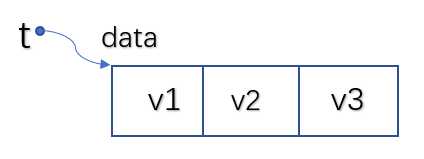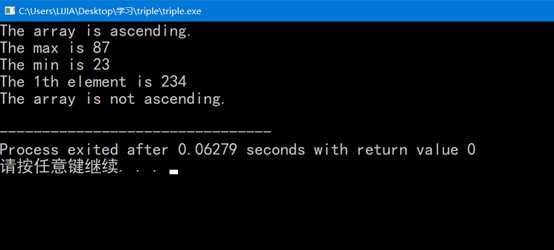标签:print 改变 数组 需要 == 转换 算法 har 更改
★数组是一种最简单的数据结构,它占据一块连续的内存并且顺序存储数据,所以我们需要首先指定数组的大小
★数组的空间效率不是很好,会有空闲的区域没有得到充分的应用
★时间复杂度为O(1);
★数组一旦被定义,它的维度和维界就不会再改变,因此除了结构的初始化和销毁之外,数组就只有存取和修改元素值得操作

⑴.建造空间并进行初始化:struct triple triple_init(int v1,int v2,int v3);
⑵.释放已开辟空间:void triple_free(struct triple t);
⑶.更改空间数据:void triple_set(struct triple t,int index,int e);
⑷.访问空间数据:int triple_get(struct triple t,int index);
⑸.判断数据是否升序:int triple_isascending(struct triple t);
⑹.判断数据是否降序:int triple_isdescending(struct triple t);
⑺.查找数据中最大值:int triple_max(struct triple t);
⑻.查找数据中最小值:int triple_min(struct triple t);
Triple.h
#ifndef __TRIPLE_H__
#define __TRIPLE_H__
//定义结构体存放存储结构数组的首地址
struct triple;
//开辟数组(内存空间),返回指向已开辟空间的指针
struct triple *triple_init(int v1,int v2,int v3);
void triple_free(struct triple *t);
//将元素存储入内存空间
void triple_set(struct triple *t,int index,int e);
//将元素从内存空间取出
int triple_get(struct triple *t,int index);
//判断数组中的元素是否为升序排列
int triple_isascending(struct triple *t);
//判断数组中的元素是否为降序排列
int triple_deascending(struct triple *t);
//从存储结构中取出数值比较,返回数组中的最大值
int triple_max(struct triple *t);
//从存储结构中取出数值比较,返回数组中的最小值
int triple_min(struct triple *t);
#endifTriple.c
#include <stdlib.h>
#include <assert.h>
#include “triple.h”
//定义结构体作为一级结构,结构体用来存放指向整型的指针变量
Struct triple{
Int *data;
}
//将v1,v2,v3存放到定义的存储结构中
Struct triple *triple_init(int v1,int v2,int v3)
{
Struct triple *t=NULL;
//使用malloc函数开辟指定内存大小的空间,返回空间首地址强制类型转换为指向triple结构体类型,最后将变量赋值到t
t=(struct triple *)malloc(sizeof(struct triple);
if(t==NULL) return NULL;
//断言t不为空
assert(t!=NULL);
t->data=NULL;
//t->data变量中存放长度为3的数组的首地址
t->data=(int *)malloc(sizeof(int)*3);
if(t->data==NULL){
free(t);
return NULL}
assert(t->data!=NULL);
t->data[0]=v1;
t->data[1]=v2;
t->data[2]=v3;
return t;
}
void triple_free(struct triple *t)
{
assert(t->data!=NULL);
assert(t!=NULL);
//将内存空间逐级释放
free(t->data);
free(t);
}
//将传入的整型元素e,插入到数组的index位置
void triple_set(struct triple *t,int index,int e)
{
assert(t!=NULL);
assert(t->data!=NULL);
assert(index>=0&&index<3);
t->data[index]=e;
}
Int triple_get(struct triple *t,int index)
{
assert(t!=NULL);
assert(t->data!=NULL);
assert(index>=0&&index<3);
return t->data[index];
}
//判断数组中的元素是否按照升序存放,是返回1,否返回0
int triple_isascending(struct triple *t)
{
assert(t!=NULL);
assert(t->data!=NULL);
if(t->data[0]<=t->data[1]&&t->data[1]<=t->data[2]){
return 1;
}
return 0;
}
int triple_isdeascending(struct triple *t)
{
return 0;
}
//通过结构体指针变量t,将数组中的元素依次取出做比较,返回最大值
int triple_max(struct triple *t)
{
int _max;
assert(t!=NULL);
assert(t->data!=NULL);
_max=t->data[0];
If(_max<t->data[1]) _max=t->data[1];
If(_max<t->data[2]) _max=t->data[2];
return max;
}
//通过结构体指针变量t,将数组中的元素依次取出做比较,返回最小值
Int triple_min(struct triple *t)
{
Int _min;
assert(t!=NULL);
assert(t->data!=NULL);
_min=t->data[0];
if(_min>t->data[1]) _min=t->data[1];
if(_min>t->data[2]) _min=t->data[2];
return _min;
}Main.c
#include <stdio.h>
#include <stdlib.h>
#include "triple.h"
int main(int argc, char *argv[]) {
struct triple *t=NULL;
t=triple_init(23,45,87);
if(triple_isascending(t)){
printf("The array is ascending.\n");
}else{
printf("The array is not ascending.\n");
}
printf("The max is %d\n",triple_max(t));
printf("The min is %d\n",triple_min(t));
triple_set(t,2,234);
printf("The 1th element is %d\n",triple_get(t,2));
if(triple_isascending(t)){
printf("The array is ascending.\n");
}else{
printf("The array is not ascending.\n");
}
triple_free(t);
return 0;
}
标签:print 改变 数组 需要 == 转换 算法 har 更改
原文地址:https://www.cnblogs.com/miaowulj/p/12235638.html